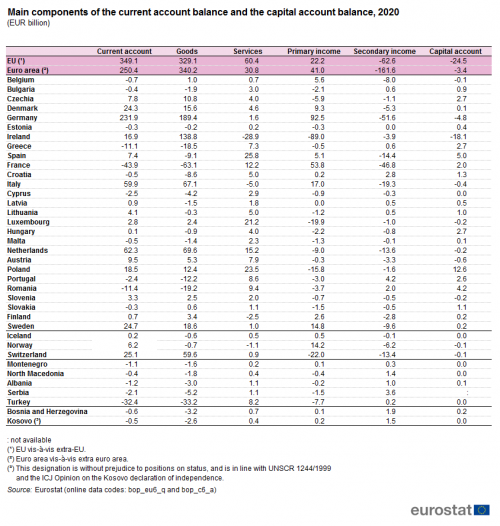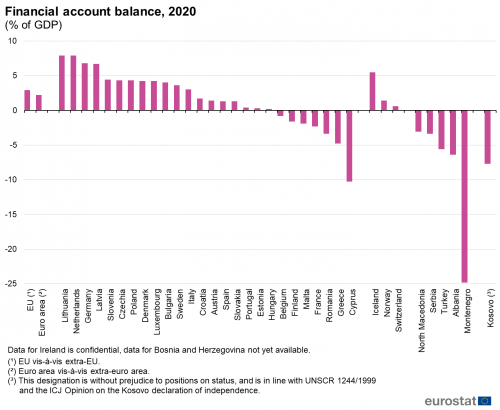Demo article - Wendy
Data extracted in May 2021.
Planned article update: 30 May 2022.
Highlights
Current account balance, 2020
The balance of payments records all economic transactions between resident and non-resident entities during a given period. This article presents data on the current and financial accounts of the balance of payments for the European Union (EU) and its Member States. Data are presented in regard to the compilation standard of the IMF’s sixth balance of payments manual (BPM6).
The balance of the current and capital accounts determines the exposure of an economy to the rest of the world[1], whereas the financial account explains how it is financed. Ideally, the balance of the current and capital accounts should equal the total net of the financial account, otherwise net errors and omissions were recorded. Articles on foreign direct investment (in chapter 4) provide more information on one component of the financial account, while an article on international trade in services focuses on one component of the current account.
Full article
Current account
The current account of the EU showed a surplus of €349.1 billion in 2020 (see Figure 1), corresponding to 2.6 % of gross domestic product (GDP). By comparison, in 2019 the current account surplus was €348.0 billion. The surplus in the current account balance for the EU increased significantly since 2009 from 0.3 % of GDP or €32.8 billion to 3.2 % in 2016 or€402.5 billion. Since then, it has been slowly decreasing in absolute values as well as a share of GDP. The current account surplus of the EU for 2020 was mostly based on a significant surplus in the goods account (2.5 % of GDP), while the services account contributed only 0.4 % of GDP and the primary income account 0.2 % of GDP to the positive balance while the secondary income account (-0.5 % of GDP) recorded a deficit. The capital account displayed also a slightly negative balance (-0.2 % of GDP) — see Figure 3.
Among EFTA countries, Switzerland €25.1 billion) reported a significant current account surplus in 2020 due to a huge surplus for goods (€59.6 billion) despite considerable negative balances for primary income (€22.0 billion) and secondary income (€13.4 billion).
Capital account
The capital account of the EU displays traditionally a deficit, resulting from considerable net capital transfers to the rest of the world. In 2020, this trend was continued with a capital account deficit of €24.5 billion, equivalent to almost 0.2 % of GDP — see Table 1. Among the Member States, Ireland recorded by far the highest capital account deficit (€18.1 billion, 4.9 % of GDP), whereas capital account surpluses of more than 2 % of GDP were reported by Croatia (2.6 %) and Poland (2.4 %) mostly due to the net receipts from EU institutions.

(€ billion)
Source: Eurostat (bop_eu6_q) and (bop_c6_a)
Financial account
The financial account consists of direct investment (FDI), portfolio investment, other investment, (net) financial derivatives and reserve assets. Financial account transactions are split in assets and liabilities that are recorded as net values (net acquisition of assets, net incurrence of liabilities). Accordingly, the financial account balance is interpreted as net lending to the rest of the world when positive, and net borrowing from the rest of the world when negative.
In 2020 the overall net value of the EU financial account was firmly positive (€387.1 billion), as was the net value of the euro area financial account (€251.9 billion). These surpluses related to 2.9 % of GDP (EU) and 2.2 % of GDP (euro area). Apart from the EU and the euro area a total of 19 EU Member States were net lenders to the rest of the world in 2020, showing surpluses in their net financial accounts. The highest value relative to their GDP (7.9 %) was reported by Lithuania and the Netherlands. By contrast, seven EU Member States were net borrowers, among those Cyprus (-10.3 % of GDP) exhibited the highest relative deficit in regards to its GDP — see Figure 5.
In 2020, the largest net lender in absolute terms in the EU was Germany with €227.6 billion (see Table 2). The German financial surplus was achieved mainly due to net acquisitions of foreign assets in portfolio (€ and employee stock options (€99.1 billion). The major hubs for financial account transactions in the EU in 2020 were Germany, Ireland, Luxembourg, France and the Netherlands.
Source data for tables and graphs
Data sources
The main methodological reference used for the production of balance of payment statistics is the sixth balance of payments manual (BPM6) of the International Monetary Fund (IMF). This new set of international standards has been developed, partly in response to important economic developments, including an increased role for globalisation, rising innovation and complexity in financial markets, and a greater emphasis on using the balance sheet as a tool for understanding economic activity (asset–liability principle).
The transmission of balance of payments data to Eurostat is covered by Regulation (EC) No 184/2005 on Community statistics concerning balance of payments, international trade in services and foreign direct investment. New data requirements according to the BPM6 manual are included in Commission Regulation (EU) No 555/2012 of 22 June 2012 and Commission Regulation (EU) No 1013/2016 of 8 June 2016 as an amendment to the above.
In April 2021, the first provisional data for the 4th quarter of 2020 became available, from which the first estimate of the annual results for 2020 have been produced.
Context
The EU is a major player in the global economy for international trade in goods and services, as well as foreign investment. Balance of payments statistics give a complete picture of all external transactions for the EU and its individual Member States. Indeed, these statistics may be used as a tool to study the international exposure of different parts of the EU’s economy, indicating its comparative advantages and disadvantages with the rest of the world, and to calibrate the implied macroeconomic risks for the economy. The financial and economic crisis 2007-2008 underlined the importance of developing such economic statistics insofar as improvements in the availability of data on the real and financial economies of the world could have helped policymakers and analysts when the crisis unfolded; for example, if internationally comparable information about financial transactions and exposure in specific assets and liabilities had been available earlier.
The European Commission launched new policy proposals in this domain aiming to stimulate the economic recovery (such as the European Fund for Strategic Investments), and to launch regular initiatives to calibrate macroeconomic risks in the EU Member States (such as the Macroeconomic imbalance procedure). Further details on the European Commission’s initiatives are available from the website of the European Commission’s Directorate-General for Economic and Financial Affairs, where more detailed information may be found on a range of recent priorities, for example Growth and Investment and the The European semester.
Direct access to
Main tables
- Compilers guide on European statistics on international trade in goods — 2017 edition Publication 17/05/2017
- Handbook on the compilation of statistics on illegal economic activities in national accounts and balance of payments Publication 06/03/2018
- Manual on goods sent abroad for processing — 2014 edition Publication 17/09/2014
Notes
- ↑ this is where i would like to have a footnote

